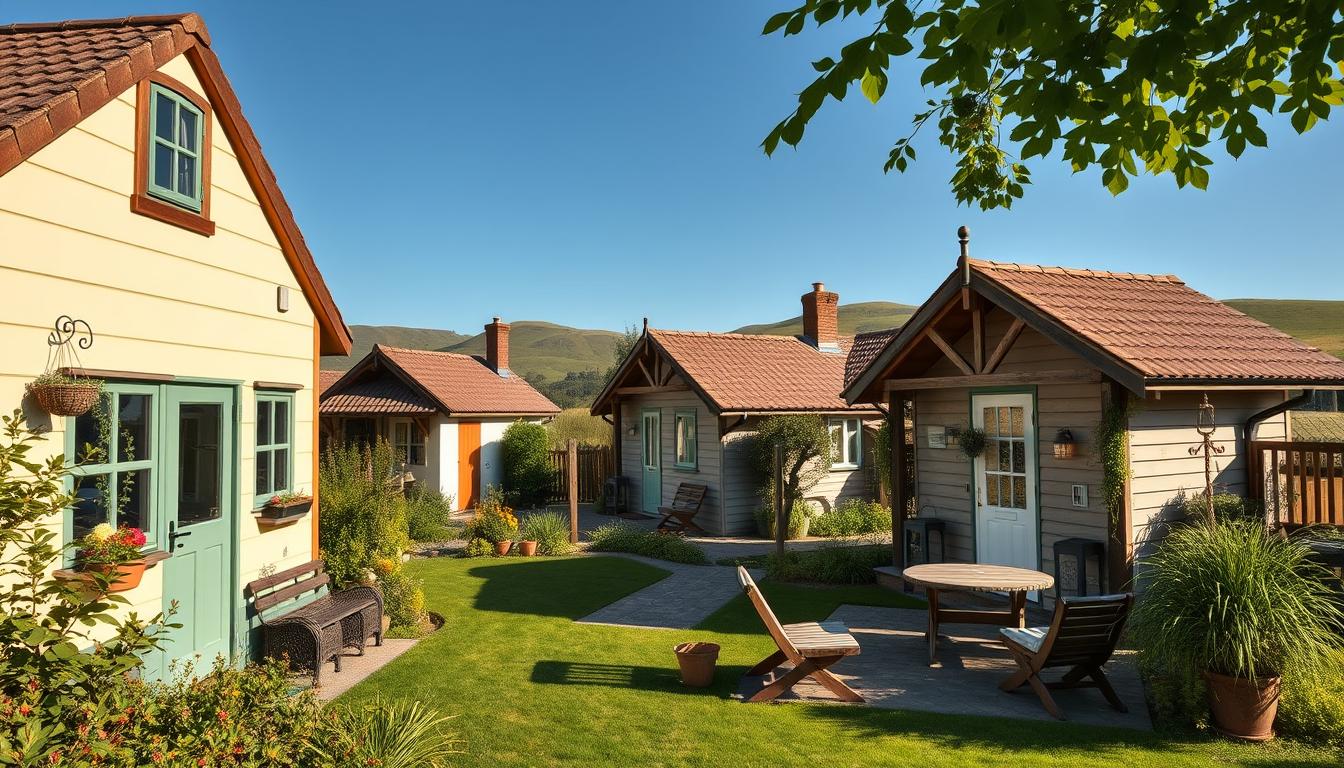Farmhouse tiny homes mix rural charm with modern simplicity. They’re perfect for those wanting a simpler, stylish life. These homes started as a trend in the UK, combining traditional farmhouse looks with tiny home efficiency.
They have wooden beams and pastoral touches, yet save space. This makes them cosy and eco-friendly. You can learn more about these charming homes here.
Key Takeaways
- Farmhouse tiny homes epitomise rustic elegance in compact living solutions.
- The average size ranges from 635 to 1,000 square feet, making them a feasible option for UK residents.
- These homes feature custom design elements like vintage nautical finds and high ceilings.
- Sustainable living is encouraged through space efficiency and reduced ecological footprints.
- Unique designs often feature wooden beams, shingled exteriors, and white shiplap interiors.
Introduction to Farmhouse Tiny Homes
Farmhouse tiny homes are more than just a place to live. They are a mix of old charm and new living. Each one is designed to be useful and beautiful, perfect for those who want efficiency and charm.
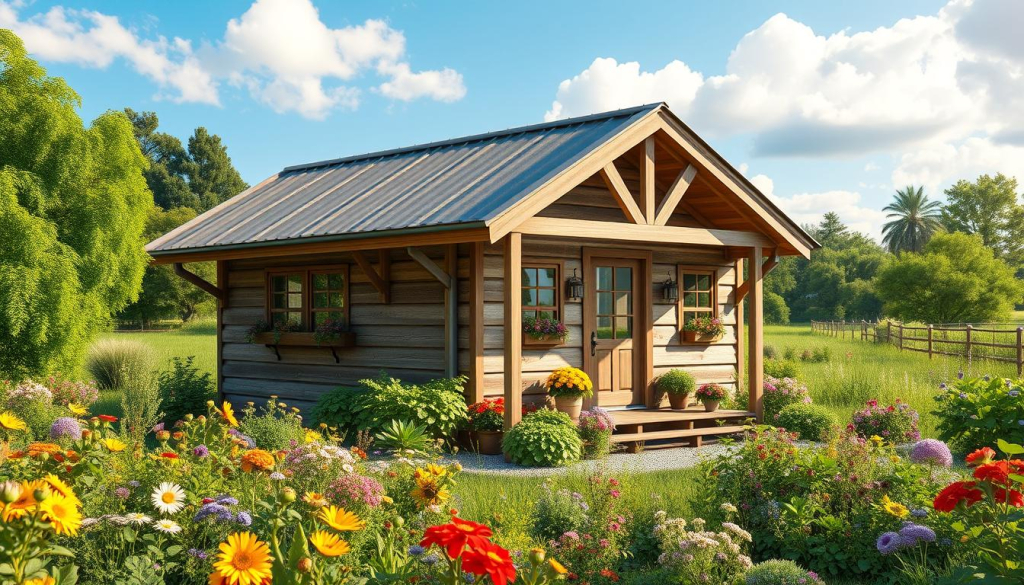
In the UK, these homes are linked to sustainable living. They offer a peaceful escape from city life. By choosing tiny living, you can live more consciously and greenly.
So, what is a farmhouse tiny home? It’s a mix of rustic looks and modern comforts. This makes it easy to live comfortably in a small, well-designed space.
The appeal of these homes goes beyond saving the planet. It’s about valuing quality over quantity. Farmhouse tiny homes are cozy and charming, using every inch wisely. They encourage a simpler, more thoughtful way of life.
In short, tiny homes, especially farmhouse styles, offer a new way of living. They are perfect for those who want to live smartly but still enjoy warmth and timeless beauty.
Design Elements of a Farmhouse Tiny Home
Farmhouse tiny homes are perfect for those who want a simple yet comfortable living space. They offer a unique blend of efficiency and style. Let’s look at the key features that make these homes stand out.
Exterior Features
Farmhouse tiny homes are known for their unique looks. They often have gabled roofs, which are not only stylish but also great for keeping water out. Here are some important exterior design elements:
- Gabled Roofs: They add a classic touch and help with water drainage, making them ideal for the UK’s weather.
- Clapboard Siding: Made from reclaimed wood, it’s eco-friendly and adds a rustic charm to the home.
- Large Porches: These porches connect the inside with the outside, making it easy to enjoy the outdoors.
- Earthy Tones: The colours used, like whites and greys, match the surroundings and reflect the farmhouse style.
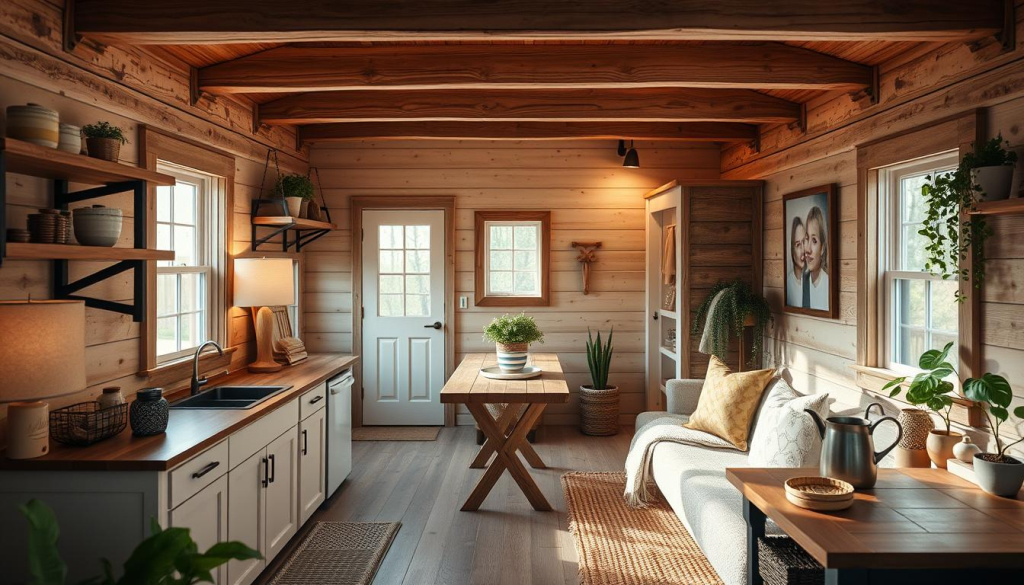
Interior Decor
Inside, these homes are designed to be both functional and welcoming. The interior design combines old and new, making the most of every inch:
- Open Floor Plans: These plans help create a spacious feel, even in a small home.
- Reclaimed Wood: Used for floors and cabinets, it brings a rustic feel to the home.
- Vintage Fixtures: Items like farmhouse sinks add to the home’s charm, mixing well with modern features.
- Earthy Colour Palette: The colours inside, like soft tones, help keep the atmosphere calm and welcoming.
Finally, big windows are a common feature. They make the homes bright and welcoming, letting in lots of natural light.
Popular Farmhouse Tiny Home Styles in the UK
In the UK, tiny homes come in many farmhouse styles. They mix practicality with charm. You can find everything from cozy bungalows to rugged cabins.
Quaint Bungalows
Quaint bungalows are all about charm and comfort. They sit on one level, fitting well into both rural and urban areas. They have big outdoor spaces and cozy interiors.
Inside, you’ll find open-plan living, well-equipped kitchens, and smart storage. These homes are big enough for different lifestyles, with areas from 217m² to 394m².
- They have three to five bedrooms, spread out over their large layouts.
- Features like French doors, oak porches, and Juliet balconies add to their appeal.
- Things like linen stores and side entrances make them practical and easy to use.
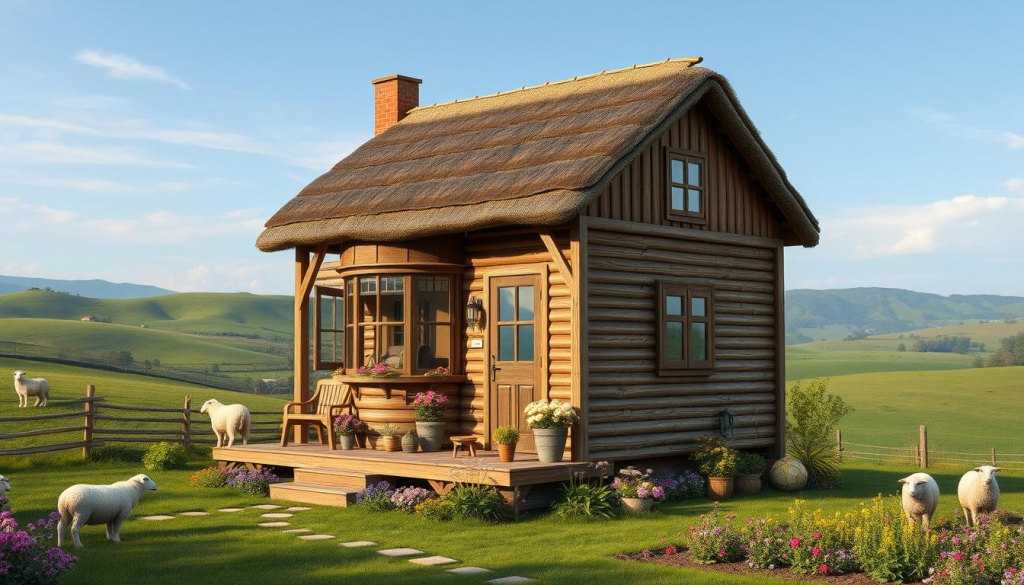
Rustic Cabins
Rustic cabins are perfect for those who love a timeless feel. They use natural materials like wood and stone. This gives them a real rustic look.
The size of these homes varies, with areas from 220m² to 394m². They often have fireplaces, open-plan kitchens, and workspaces for comfort.
- Modern touches, like mid-century antiques, add a unique twist to their cosy interiors.
- Textiles like nubbly linens and textured wool make them warm and welcoming.
Both bungalows and cabins show how farmhouse tiny homes in the UK have evolved. They suit different tastes and needs, making them popular among tiny home lovers.
Benefits of Living in a Farmhouse Tiny Home
Living in a farmhouse tiny home has many advantages. It’s a great choice for those who want a simple life. One big benefit of tiny homes is how good they are for the environment. They use less carbon than big houses, helping us live more sustainably.
In the UK, tiny homes are popular for reducing carbon footprint. They are small, ranging from 10 to 40 square meters. This means they use space well, making cleaning and upkeep easy.
Cost is another big plus. Tiny homes in the UK cost between £40,000 and £60,000. This is cheaper than regular houses. Plus, they cost less to live in because they need less power and resources.
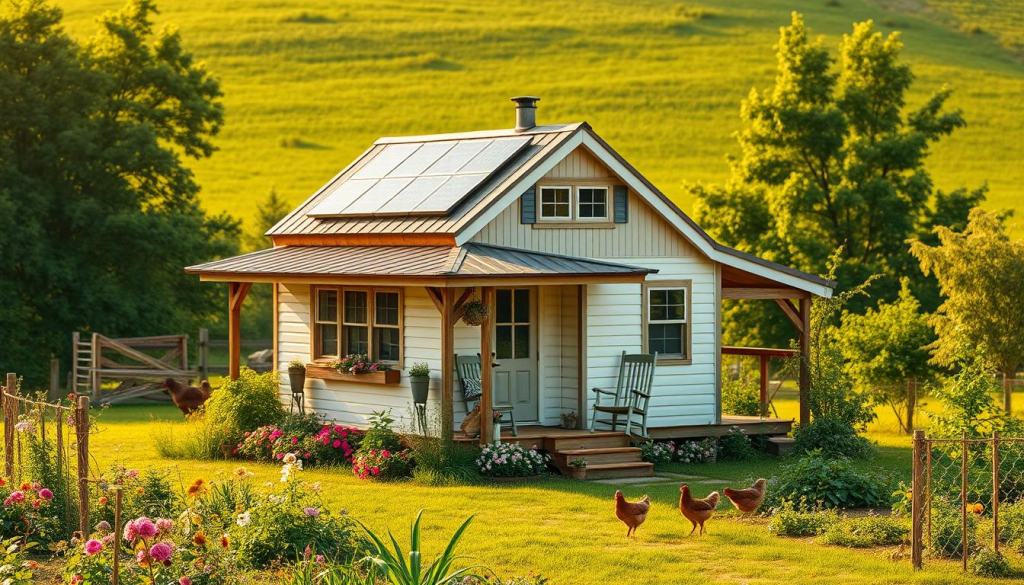
Also, tiny homes can be placed easily if they follow the Caravan Act. This makes them a good choice for those who want to place their home on family land. It helps avoid some planning rules.
Living in a tiny home also means being part of a community. Tiny home lovers share values like living sustainably and supporting each other. This creates a strong sense of community and friendship.
To sum up, tiny homes offer many benefits. They help us live sustainably, support a simple lifestyle, and are affordable. These reasons make farmhouse tiny homes a great choice for many in the UK.
Famous Farmhouse Tiny Home Examples in the UK
The UK boasts many famous tiny homes that have caught the eye of the media. Each tiny home stands out with its unique design, eco-friendly features, and connection to heritage. They are often highlighted in architectural magazines and lifestyle publications, inspiring many.
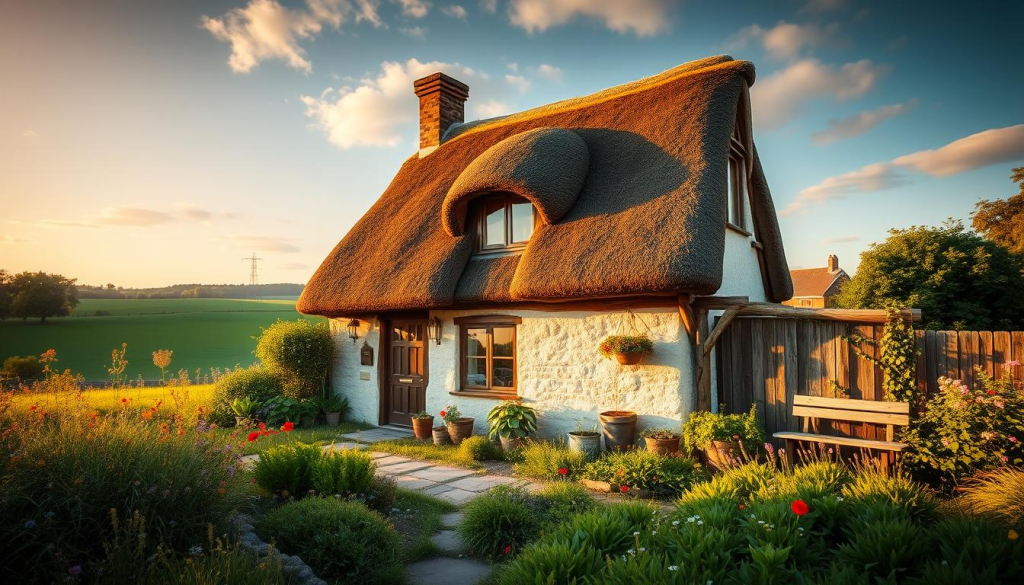
The farmhouse tiny home in Devon is a stunning example. It combines rustic charm with a vintage interior. The design is eco-friendly and features a galvanized metal roof, a modern touch seen in 40% of such homes.
Another standout is the converted boathouse in the Lake District. It beautifully merges history with modern comforts, staying around 880 square feet. Its location near water offers a serene, nature-rich lifestyle.
About 25% of UK farmhouse tiny homes have nautical or vintage themes. This blend of old and new creates a welcoming space. Some are even built for off-grid living, showing the rise in eco-friendly tiny homes.
For those keen to see these architectural wonders, Houzz and Home of Tiny are great resources. They showcase some of the UK’s finest farmhouse tiny homes.
Design Tips for Your Farmhouse Tiny Home
Turning your tiny home into a charming farmhouse is all about clever design and smart choices. You can make it feel big and cosy at the same time. We’ll look at how to use space well and pick the best materials for your home.
Maximising Space
Living in a tiny home means finding ways to save space. Here are some tips to help you use every inch wisely:
- Multi-functional Furniture: Choose items like ottomans with storage, murphy beds, or sofa beds. They do more than one thing, making your space more efficient.
- Vertical Storage: Use the height of your home with shelves and cabinets that go up. This frees up floor space and keeps things tidy.
- Bespoke Built-ins: Custom storage, like built-in wardrobes and kitchen units, fits your home perfectly. It makes the most of every inch.
- Use of Loft Areas: Loft areas are great for sleeping or storage. They help keep the living area open and uncluttered.
- Wall Décor: Hang things on walls, like hats or shelves, to keep surfaces clear. It’s a smart way to decorate and store things.
Choosing the Right Materials
Choosing eco-friendly materials is key for a sustainable and stylish farmhouse tiny home. Here are some good options:
- Reclaimed Wood: Reclaimed wood adds a rustic touch and is good for the planet. It’s a great choice for flooring, ceilings, or furniture.
- Natural Fabrics: Use natural fabrics like linen or cotton for upholstery. They’re good for the environment and fit the farmhouse style.
- Low-VOC Paints: Pick paints with low VOCs for your walls. They’re better for the air and look good too.
- Stone and Ceramic Tiles: Stone or black ceramic tiles are perfect for kitchens and bathrooms. They look great and last a long time.
- Energy-efficient Appliances: Get appliances that use less energy. They help cut down on your carbon footprint and save money.
For more ideas on making your tiny home a farmhouse retreat, check out this guide.
Using these design tips and eco-friendly materials will make your tiny home more functional and beautiful. It also shows your commitment to living green.
Conclusion
The farmhouse tiny home movement has grown from a buzz to a key part of the future of housing. It combines the charm of rustic design with eco-friendly solutions. These homes offer comfort and sustainability in a small space.
These tiny homes are usually between 100 and 400 square feet. But, modern farmhouse tiny homes can have a 104 square-foot ceiling. This makes them feel more spacious and versatile.
Cost-efficiency is a big plus. Building a traditional log cabin can cost £250,000 to £450,000. But, a tiny house can be built for £30,000 to £70,000. This makes tiny living a smart, eco-friendly choice and a budget-friendly option.
It also helps solve the UK’s housing crisis. By cutting down on costs and maintenance, tiny homes are a practical solution.
The movement is all about simplicity and sustainable living. Many tiny homes use reclaimed wood, recycled metal, and low-VOC paints. They also have solar panels, composting toilets, and rainwater systems. To learn more, visit the benefits of tiny homes.
Choosing a farmhouse tiny home means joining a community that values eco-conscious living. It’s a step towards a greener, more connected lifestyle. Join the tiny home movement today.


